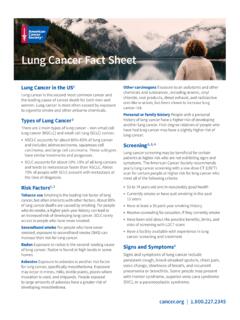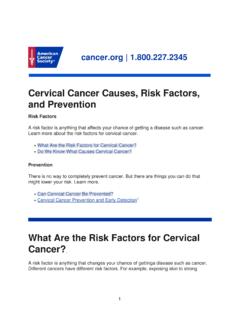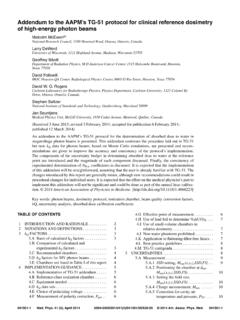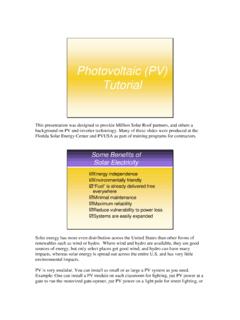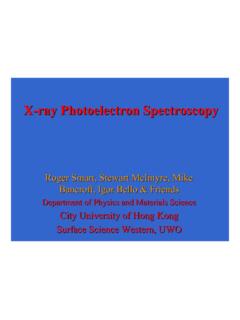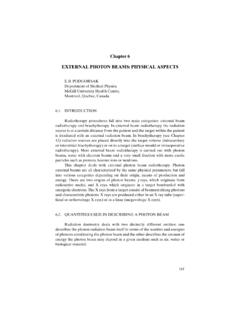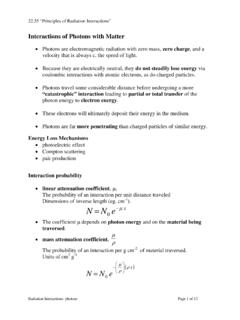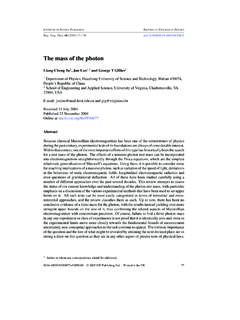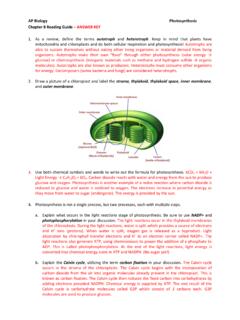Transcription of The Science Behind Radiation Therapy
1 The Science Behind Radiation TherapyHere you'll find a more in-depth discussion of what Radiation Therapy is and how it isused to treat does Radiation work to treat cancer?lTypes of Radiation used to treat cancerlGoals of Radiation therapylWho gives Radiation treatments?lHow is Radiation given?lExternal beam radiationlInternal Radiation Therapy (brachytherapy)lRadiopharmaceuticalslDoe s Radiation Therapy cause second cancers?lWhat s new in Radiation Therapy ?lTo learn morelReferenceslHow does Radiation work to treatcancer? Radiation is energy that s carried by waves or a stream of particles. Radiation works bydamaging the genes (DNA) in cells. Genes control how cells grow and divide. Whenradiation damages the genes of cancer cells, they can t grow and divide any more. Overtime, the cells die. This means Radiation can be used to kill cancer cells and cell cycleTo understand how Radiation works as a cancer treatment, it helps to know the normallife cycle of a cell.
2 The cell cycle has 5 phases, one of which is the actual splitting of thecell. When a cell splits, or divides, into 2 cells, it s called mitosis. This 5-phase processis controlled by proteins known as cyclin-dependent kinases (CDKs). Because CDKsare so important to normal cell division, they too have a number of control cell cycleG0 = Cell rests (it s not dividing) and does its normal work in the bodyG1 = RNA and proteins are made for dividingS = Synthesis (DNA is made for new cells)G2 = Apparatus for mitosis is builtM = Mitosis (the cell divides into 2 cells)Steps of the cell cycleG0 phase (resting stage): The cell has not yet started to divide. Cells spend much oftheir lives in this phase, carrying out their day-to-day body functions, not dividing orpreparing to divide. Depending on the type of cell, this stage can last for a few hours ormany years.
3 When the cell gets the signal to divide, it moves into the G1 phase: The cell gets information that determines if and when it will go into the nextphase. It starts making more proteins to get ready to divide. The RNA needed to copyDNA is also made in this phase. This phase lasts about 18 to 30 phase: In the S phase, the chromosomes (which contain the genetic code or DNA)are copied so that both of the new cells to be made will have the same DNA. This phaselasts about 18 to 20 phase: More information about if and when to proceed with cell division is gatheredduring this phase. The G2 phase happens just before the cell starts splitting into 2 lasts from 2 to10 phase (mitosis): In this phase, which lasts only 30 to 60 minutes, the cell actuallysplits into 2 new cells that are exactly the and radiationThe cell cycle phase is important because usually Radiation first kills the cells that areactively dividing.
4 It doesn t work very quickly on cells that are in the resting stage (G0)or are dividing less often. The amount and type of Radiation that reaches the cell and thespeed of cell growth affect whether and how quickly the cell will die or be damaged. Theterm radiosensitivity describes how likely the cell is to be damaged by cells tend to divide quickly and grow out of control. Radiation Therapy killscancer cells that are dividing, but it also affects dividing cells of normal tissues. Thedamage to normal cells causes unwanted side effects. Radiation Therapy is always abalance between destroying the cancer cells and minimizing damage to the doesn t always kill cancer cells or normal cells right away. It might take daysor even weeks of treatment for cells to start dying, and they may keep dying off formonths after treatment ends. Tissues that grow quickly, such as skin, bone marrow, andthe lining of the intestines are often affected right away.
5 In contrast, nerve, breast, brain,and bone tissue show later effects. For this reason, Radiation treatment can cause sideeffects that might not be seen until long after treatment is Medical Review: October 27, 2014 Last Revised: October 27, 2014 American Cancer Society medical information is copyrighted material. For reprintrequests, please contact of Radiation used to treat cancerRadiation used for cancer treatment is called ionizing Radiation because it forms ions(electrically charged particles) in the cells of the tissues it passes through. It createsions by removing electrons from atoms and molecules. This can kill cells or changegenes so the cells stop forms of Radiation such as radio waves, microwaves, and visible light waves arecalled non-ionizing. They don t have as much energy and are not able to form Radiation can be sorted into 2 major types: photon Radiation (x-rays and gamma rays)lParticle Radiation (such as electrons, protons, neutrons, carbon ions, alphaparticles, and beta particles)lSome types of ionizing Radiation have more energy than others.
6 The more energy, themore deeply the Radiation can penetrate (get into) the way each type of Radiation behaves is important in planning Radiation treatments. Aradiation oncologist (a doctor specially trained to treat cancer with Radiation ) selects thetype of Radiation that s most suitable for each patient s cancer type and radiationA high-energy photon beam is by far the most common form of Radiation used forcancer treatment. It is the same type of Radiation that is used in x-ray machines, andcomes from a radioactive source such as cobalt, cesium, or a machine called a linearaccelerator (linac, for short). photon beams of energy affect the cells along their path asthey go through the body to get to the cancer, pass through the cancer, and then exitthe radiationElectron beams or particle beams are also produced by a linear are negatively charged parts of atoms.
7 They have a low energy level anddon t penetrate deeply into the body, so this type of Radiation is used most often to treatthe skin, as well as tumors and lymph nodes that are close to the surface of the beams are a form of particle beam Radiation . Protons are positively chargedparts of atoms. They release their energy only after traveling a certain distance andcause little damage to the tissues they pass through. This makes them very good atkilling cells at the end of their path. So, proton beams are thought to be able to delivermore Radiation to the cancer while doing less damage to nearby normal beam Radiation Therapy is used routinely for certain types of cancer, but still needmore study in treating others. It requires highly specialized equipment and is not of the techniques used in proton treatment can also expose the patient toneutrons (see below).
8 Neutron beams are used for some cancers of the head, neck, and prostate and forcertain inoperable tumors. A neutron is a particle in many atoms that has no beam Radiation can sometimes help when other forms of Radiation Therapy don twork. Few facilities in the United States offer it, and use has declined partly because itcan be difficult to target the beams effectively. Because neutrons can damage DNAmore than photons, effects on normal tissue can be more ion Radiation can be helpful in treating cancers that don t usually respond wellto Radiation (called radioresistant cancers). It s also called heavy ion Radiation because ituses a particle that s heavier than a proton or neutron. The particle is part of the carbonatom, which itself contains protons, neutrons, and electrons. Because it s so heavy, itcan do more damage to the target cell than other types of Radiation .
9 As with protons, thebeam of carbon ions can be adjusted to do the most damage to the cancer cells at theend of its path. But the effects on nearby normal tissue can be more severe. This typeof Radiation is only available in a few centers in the and beta particles are mainly produced by special radioactive substances thatmay be injected, swallowed, or put into the body. They re most often used in imagingtests, but can be helpful in treating cancer. You can read more about thesein Medical Review: October 27, 2014 Last Revised: October 27, 2014 American Cancer Society medical information is copyrighted material. For reprintrequests, please contact of Radiation therapyMost types of Radiation are considered local treatments because the Radiation is aimedat a specific area of the body (where there s a tumor). Only cells in that area areaffected.
10 Most forms of Radiation Therapy can t reach all parts of the body, which meansthey re not helpful in treating cancer that has spread to many distant is used to treat cancer in several cure or shrink early stage cancerSome cancers are very sensitive to Radiation . Radiation may be used by itself in thesecases to make the cancer shrink or disappear completely. Sometimes, a few cycles ofchemotherapy are given first. For other cancers, Radiation may be used before surgery(as pre-operative or neoadjuvant Therapy ) to shrink the tumor, or after surgery to helpprevent the cancer from coming back (this is called adjuvant Therapy ).For certain cancers that can be cured either by Radiation or by surgery, Radiation may bepreferred because it can sometimes preserve the organ s function (such as that of thelarynx or the anus).In treating some types of cancer, Radiation may also be used along with chemotherapy(chemo).

